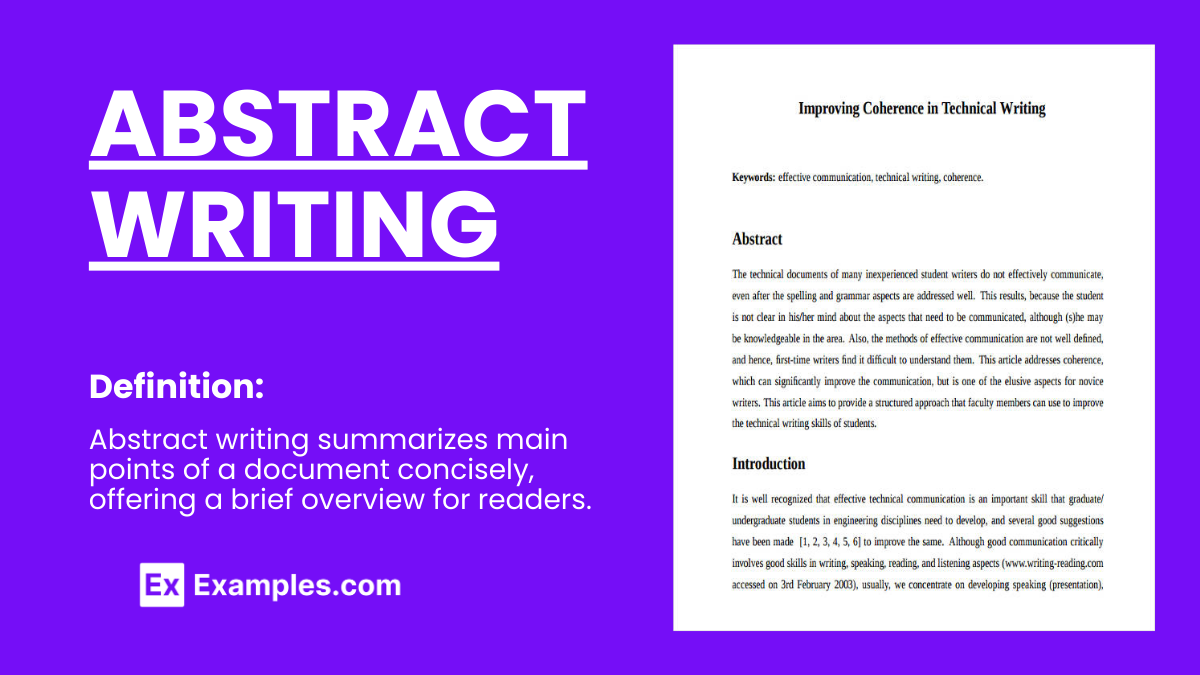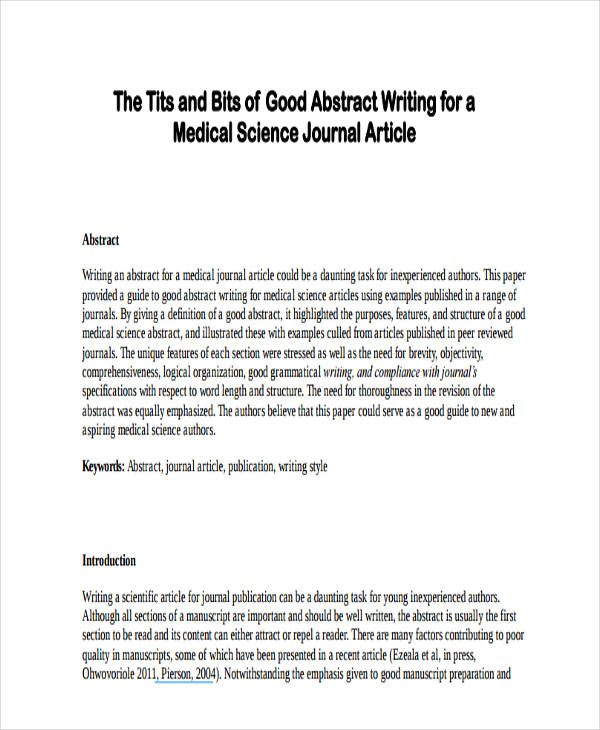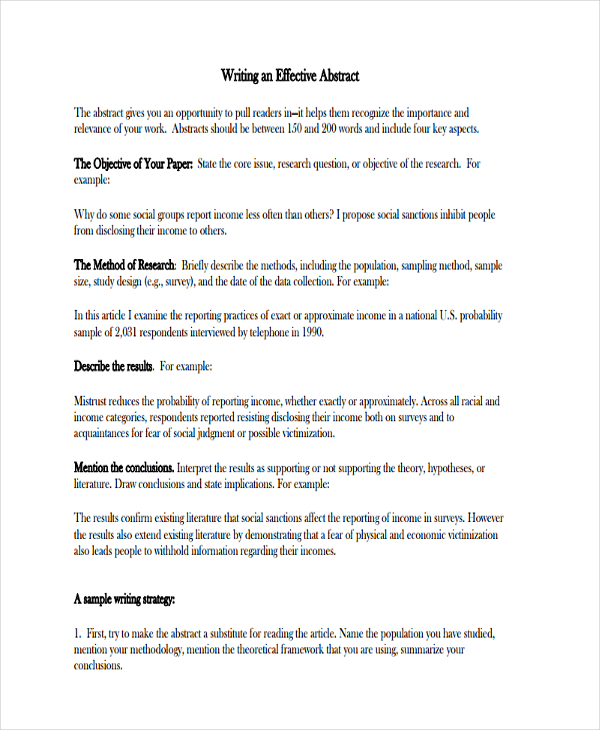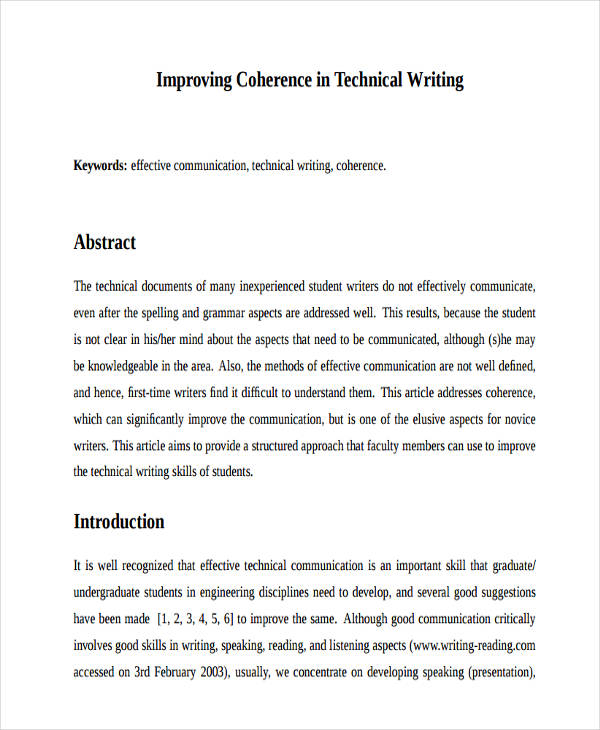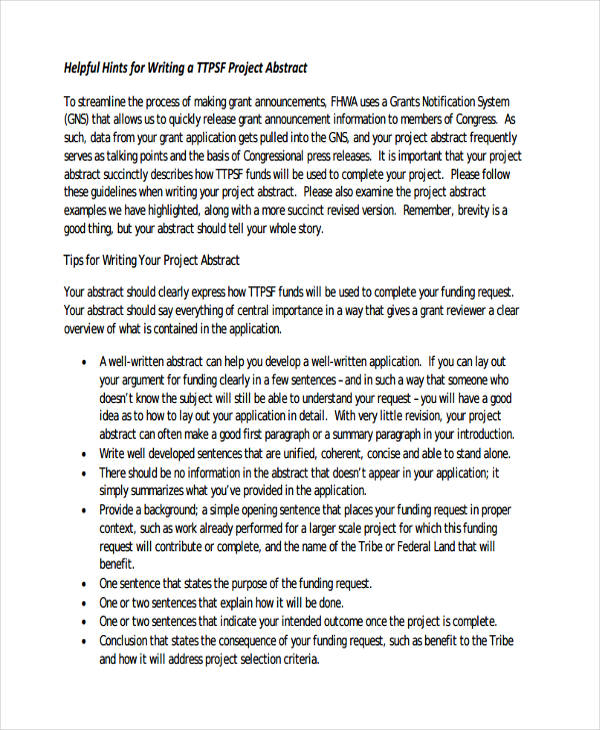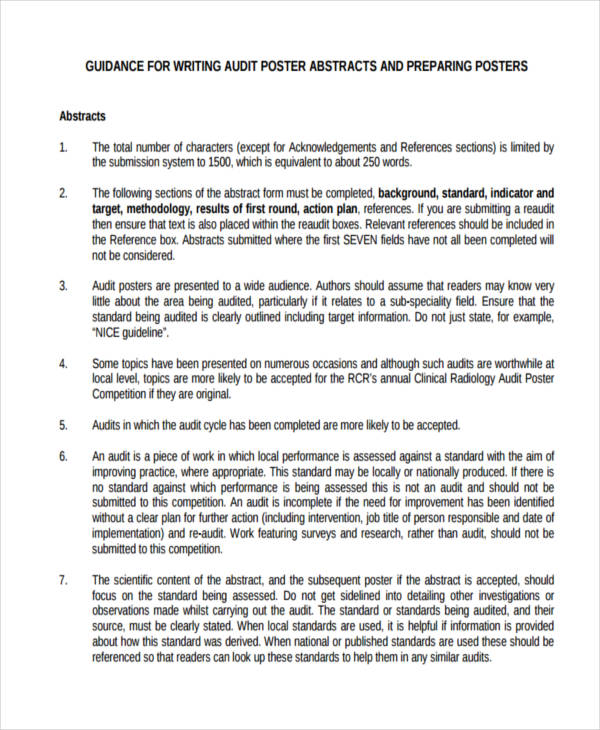30+ Abstract Writing Examples to Download
Documents such as research papers, journal article, review, thesis, conference proceedings, etc. are lengthy and detailed, which causes it to be time-consuming and difficult to understand. In some cases, compositions like these that are still waiting for a committee’s approval are just impractical to be read entirely. For this reason, an abstract is truly an essential part of any educational paper. To know more about abstract writing, read through this article.
In the field of education alone, there are already several documents that need to include an abstract. A thesis paper for instance also requires an abstract. Thus, there is no need to doubt why there are numerous forms of abstracts. To give you a broader overview of these segments, here is a compilation of some samples and templates we prepared for you.
What is Abstract Writing?
Abstract writing is the process of creating a concise and clear summary of a larger work, such as a research paper, thesis, dissertation, or scholarly article. The purpose of an abstract is to provide a brief overview of the main points, methods, results, and conclusions of the work, enabling readers to quickly determine its relevance to their interests or research needs. Abstracts are typically a single paragraph, ranging from about 150 to 250 words, depending on the guidelines of the publication or academic institution.
Abstract Writing Format
Title
- Clear and Descriptive: Reflects the main topic or findings of the work.
Introduction
- Background: Brief context or background information leading to the research question or objective.
- Objective/Purpose: A statement of the main aim or research question addressed by the work.
Methods
- Approach: A brief description of the research design, methods, and materials used. This section explains how the study was conducted but in a very condensed manner.
Results
- Findings: Key results or findings of the research, including data, trends, and any significant discoveries. This section should be factual and concise, highlighting only the most important results.
Conclusion
- Implications: The main conclusions drawn from the results, including the relevance, implications, and potential impact of the findings. This may also include recommendations or future research directions.
Example of Abstract Writing
Free Download in Word Free Download in PDFThe Effects of Urban Noise Pollution on Birdsong Adaptation
Abstract: Urbanization has led to significant environmental changes, affecting biodiversity and wildlife behavior. This study examines the impact of urban noise pollution on birdsong adaptation in three major cities: New York, London, and Tokyo. Using field recordings collected over two years, we analyzed frequency changes, song length, and timing adaptations in common urban bird species. Our findings reveal that birds in noisier environments exhibit higher frequency songs, shorter song lengths, and shifts to dawn and dusk singing to avoid peak noise periods. Specifically, the average frequency increase was noted to be approximately 1.2 kHz in areas with decibel levels exceeding 70 dB.
Additionally, song length was reduced by an average of 20% in high-noise habitats. These adaptations suggest a significant impact of noise pollution on avian communication and mating rituals. The study underscores the importance of incorporating wildlife preservation efforts in urban planning and noise reduction strategies. Future research should focus on the long-term evolutionary implications of these behavioral adaptations and their impact on bird populations in urban environments.
Keywords: noise pollution, birdsong adaptation, urban biodiversity, avian communication, urban planning
Medical Abstract Sample
Free Download in Word Free Download in PDFThe Impact of Climate Change on Global Biodiversity: An Urgent Call for Conservation Action
Climate change poses an unprecedented threat to global biodiversity, with far-reaching consequences for ecosystems, species survival, and biodiversity hotspots worldwide. This study synthesizes current research on the impacts of climate change on biodiversity, drawing on data from a range of ecosystems including forests, oceans, and freshwater habitats. Our analysis reveals that climate change, characterized by rising temperatures, altered precipitation patterns, and increased frequency of extreme weather events, is significantly affecting species distribution, population dynamics, and ecosystem functions. Notably, approximately 25% of species in assessed animal and plant groups are already threatened by climate change, underscoring the risk of mass extinctions if current trends continue.
The study highlights critical areas such as the Amazon rainforest, the Great Barrier Reef, and the Arctic, where the effects of climate change are particularly pronounced. The loss of biodiversity in these areas not only diminishes global ecological richness but also undermines ecosystem services vital to human survival, including pollination, water purification, and climate regulation. Our findings emphasize the urgent need for comprehensive conservation strategies that incorporate climate change mitigation, habitat preservation, and the restoration of degraded ecosystems. Furthermore, international cooperation and the integration of biodiversity conservation into climate policies are essential to address the global scope of the challenge. This study serves as a stark reminder of the interconnectedness of climate change and biodiversity loss and the need for immediate action to preserve the natural world for future generations.
Keywords: climate change, biodiversity, conservation, ecosystems, species extinction
Example of Abstract in Research
Free Download in Word Free Download in PDFAdvancements in Artificial Intelligence: Ethical Implications and Future Prospects
The rapid advancement of artificial intelligence (AI) technologies has ushered in a new era of innovation, fundamentally transforming industries, economies, and societal norms. This research paper explores the multifaceted implications of AI developments, focusing on ethical considerations, potential societal impacts, and the future trajectory of AI integration into various sectors. By examining recent advancements in machine learning, autonomous systems, and AI-driven analytics, we identify key areas of growth and the potential for AI to enhance efficiency, decision-making processes, and personalized services. However, alongside these benefits, the study highlights significant ethical concerns, including privacy issues, algorithmic bias, job displacement, and the challenges of AI governance.
In addressing these ethical considerations, the research emphasizes the importance of developing robust ethical frameworks and regulatory policies to guide AI development and deployment. The analysis suggests that proactive measures, including transparency in AI algorithms, stakeholder engagement, and interdisciplinary research, are critical to addressing ethical dilemmas and ensuring AI technologies benefit society as a whole. Moreover, the paper discusses the potential for AI to address global challenges, such as healthcare delivery, climate change mitigation, and sustainable development, underlining the necessity of ethical AI innovation to achieve long-term societal goals. The findings advocate for a balanced approach to AI development, one that harnesses its transformative potential while mitigating associated risks through ethical practices and governance. This study contributes to the ongoing discourse on the future of AI, urging a collaborative effort among technologists, policymakers, and ethicists to shape a future where AI serves as a force for good.
Keywords: Artificial Intelligence, Ethical Implications, Machine Learning, AI Governance, Sustainable Development
Topics for Abstract Writing with Samples to Edit & Download
- Climate Change and Environmental Sustainability
- Artificial Intelligence and Machine Learning
- Public Health and Pandemics
- Cybersecurity and Data Privacy
- Mental Health and Wellbeing
- Renewable Energy Technologies
- Economic Inequality and Social Justice
- Space Exploration and Technology
- Gene Editing and CRISPR Technology
- Sustainable Urban Development
- Digital Transformation in Education
- Blockchain and Financial Technologies
- Cultural Heritage and Digital Preservation
- Nutrition and Food Security
- Quantum Computing
- Autonomous Vehicles and Future Transportation
- Plastic Pollution and Waste Management Solutions
- Virtual and Augmented Reality in Education and Training
- Impact of Social Media on Society and Interpersonal Relationships
- Advances in 3D Printing Technology and Its Applications
- APA Abstract
Abstract Writing Examples & Templates
Free Lease Abstract Template

Medical Abstract Writing
Sample Abstract Writing Outline
Abstract Technical Writing
Abstract Thesis Writing
Project Abstract Writing Example
Poster Abstract Writing
How to Write a Conference Presentation Abstract
A conference presentation is a form of engagement and communication approach that aims to disseminate pieces of educational information about a particular topic to several people. Considering that you are likely to introduce fresh details to a vast amount of audience, an abstract should be provided to the conference committee beforehand. This brief document which is usually composed of 200-400 words, serves as the pass for a proponent to proceed in conducting a conference presentation.
Hearing the term “abstract” may intimidate you; however, do not be fooled with your thoughts. Once you have already created your paper, composing your abstract will be as easy as cake. If still, you do not believe, here are seven easy steps in constructing your conference presentation abstract to prove you wrong.
1. Understand your entire conference presentation.
An abstract is a summary of your whole presentation and though it is only briefly composed, the content of your conference brief should be as meaty as your presentation itself. Before writing even a single letter for your abstract, see to it that you truly comprehended your entire document. By doing this, it would be easier for you to distinguish the necessary details that need to be included.
2. Identify the background.
The background of your conference presentation refers basically to the reason why you are doing that talk. Generally, it focuses on the dilemmas you want to address or a context you want to enhance. It also includes the severity of the problem and its causes. It also discusses why this difficulty has never been addressed before as well as its current situation. Also, your expectations and hypothesis may be included in this section as well.
3. Know your approach.
An approach of a conference presentation depicts the steps you have taken to address the said problem. Basically speaking, this segment refers to your methodology. The approach includes the kind of data did you gathered and your method of data collection. It also tackles about your assessment of these collected details. The respondents of your study, as well as their population number, are also mentioned in your approach. Nevertheless, do not forget to identify the genre of your topic. You may indicate whether it is data analysis, an annual business report, case study, etc.
4. Distinguish the findings or results.
This portion fundamentally talks about your discoveries from the said study. Simply reflect on the results of the study. State whether the new technique or approach turned out to be effective or not. Moreover, mention the new details you found from the research. Specify the things that are confirmed or rejected in your experiment, too. You may also indicate if there are any unexpected changes or interesting events that occurred.
5. Determine the conclusion.
The conclusion primarily pertains to the generalization you have derived out from the mentioned outcomes. In this segment, you may mention the phenomena tailed by your data and the necessary measurements in regards to the said event. You may indicate the effect of your findings to your audience as well.
6. Summarize these five key details.
To finally compose your own abstract, simply summarize these pieces of information mentioned above. Given that the average count of an abstract is about 200-400 words, briefly wrap everything up. In doing this step, consider including only the most important information. Hence, do not state everything said in your abstract. Simply provide the committee with an interesting clue on your presentation’s content.
7. Proofread.
Before submitting anything, practice to review your compositions. Though it is the idea within your abstract that matters the most, it is an undeniable fact that error-free grammar and spelling could enhance the presentation of your work and establish a good impression. Furthermore, it could also help you achieve better communication with your reader.
Types of Abstract Writing
- Informative Abstracts: Provide a comprehensive summary of the research, including the purpose, methods, results, and conclusions. This type is detailed and acts as a surrogate for the actual document.
- Descriptive Abstracts: Offer a general overview of the work without delving into results or conclusions. They typically describe the purpose and scope of the research, serving more as an invitation to read the full document.
- Critical Abstracts: In addition to summarizing the work, these evaluate or critique the research’s validity, reliability, or completeness. Critical abstracts are less common and are usually found in academic review articles.
- Highlight Abstracts: Designed to capture the reader’s interest, they emphasize the most exciting or novel aspects of the research, often leaving out less significant details. Highlight abstracts are used for marketing or promotional purposes.
- Structured Abstracts: Follow a specific format that requires the author to fill in sections such as Background, Objective, Methods, Results, and Conclusion. This format is common in medical and scientific journals for its clarity and ease of reading.
How to Write an Abstract
1. Understand the Purpose of Your Abstract
- Informative Abstract: Provides a comprehensive summary of the work, including the purpose, methodology, results, and conclusions.
- Descriptive Abstract: Offers a brief description of the work without going into detailed results or conclusions, focusing on the purpose and scope.
2. Review the Requirements
- Check any specific guidelines provided by the journal, conference, or institution regarding length, format, and content.
3. Identify Key Elements to Include
- Purpose: Clearly state the main objective and scope of the work.
- Methodology: Briefly describe the methods used to conduct the research or work.
- Results: Summarize the main findings or outcomes, including significant data points if applicable.
- Conclusions: Highlight the key conclusions, implications, and the significance of the findings.
- Keywords: Include a list of keywords that reflect the main content areas of the work.
4. Write the Draft
- Start with a Draft: Begin by drafting each section of the abstract without worrying about the word limit.
- Be Specific and Direct: Use precise language to convey the essential points of your work.
- Avoid Jargon: Write in clear and accessible language, avoiding unnecessary technical jargon.
5. Revise and Refine
- Condense Information: Reduce each section to its essence, ensuring you stay within the word limit.
- Ensure Coherence: Check that the abstract flows logically from the purpose through to the conclusions.
- Accuracy: Verify that the abstract accurately reflects the content of your paper or project.
6. Final Checks
- Compliance with Guidelines: Ensure your abstract meets all specified requirements for length and format.
- Proofreading: Carefully proofread for spelling, grammar, and clarity. It may help to have someone else review it as well.
- Consistency: Make sure the abstract stands alone and provides a complete picture of your work without needing to refer to the paper.
Tips for Abstract Writing
An effective abstract can stand on its own. This means that the reader will find the information on the abstract enough to understand the whole market research, even if he/she does not continue reading the rest of the paper. So if you’re finding the process a bit difficult, you might find these tips helpful.
- Know the purpose of writing an abstract. Before writing the abstract, you need to first identify the reason why you need to write it, and the purpose of writing the entire paper.
- Complete the paper. Write and understand your paper before writing the abstract. After all, you cannot give a summary writing of something if you do not understand its content.
- Understand the format for writing the abstract. The format often depends on the research you are writing. Some elements found in the abstract of a scientific paper might not be included in that of a research paper in other fields, like humanities.
- Consider the readers. They will be the one to benefit the most if your abstract is written well.
- Give a clear explanation of your paper. Define your entire study, give the key information included in your study, and provide a glimpse of the paper’s entirety.
- Organize. Write the information in order, so you don’t confuse your readers.
- Revise. Read and re-read your abstract, find some errors which you can correct, and make sure it’s polished before submission.
What is the Purpose of an Abstract?
The purpose of an abstract is to provide a succinct summary of a research paper or report, allowing readers to quickly grasp the key points, methodology, results, and conclusions. It helps determine the relevance of the document for their purposes.
When Should I Write the Abstract?
An abstract should be written after completing the main body of your work. This ensures that you have a clear overview of all the key points, findings, and conclusions, enabling you to summarize the content accurately and effectively in a concise manner.
Who Writes an Abstract?
The abstract is typically written by the author(s) of the research paper, thesis, or report. It requires a deep understanding of the study’s objectives, findings, and significance, making the original author(s) the most qualified to distill this information into a concise summary.


